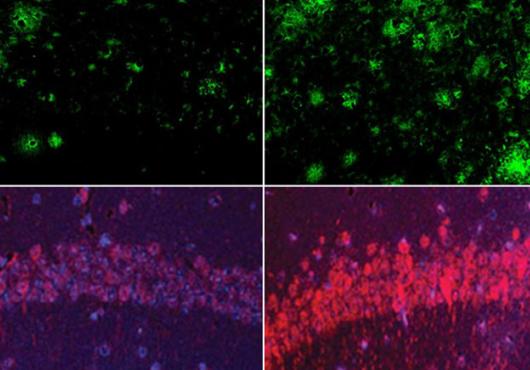Reduce. Reuse. Recycle. We hear this mantra time and again. When it comes to carbon—the “most wanted” element in terms of climate change—nature has got reuse and recycle covered. But it’s up to us to reduce. Scientists at HMS are trying to meet this challenge by learning more about the carbon cycle, the process by which carbon moves from the atmosphere into plants, oceans, soils, the Earth’s crust and back into the atmosphere again.
Among the greatest movers and shakers are the lowly cyanobacteria, a group of ocean-dwelling, one-celled organisms. Pamela Silver, HMS professor of systems biology, and colleagues have uncovered details about how these bacteria fix, or digest, carbon. These bacteria, which are responsible for approximately 40 percent of the Earth’s photosynthetic cycling of carbon, build miniature factories inside themselves that turn carbon into fuel. Silver found that the bacteria organize these factories spatially, showing a structural sophistication not often seen in single-celled organisms. This regular and predictable spacing improves the efficiency of carbon processing. In the future, an understanding of the mechanisms that govern this spatial organization may help improve the efficiency of designer bacteria engineered to produce carbonneutral, or clean-burning, fuels such as biodiesel or hydrogen.
The findings appear in the March 5 Science.
Floating FactoriesThe rod-shaped cyanobacteria are among the most abundant organisms on Earth, which is what allows them, collectively, to recycle such a large percentage of the Earth’s carbon. To process carbon, cyanobacteria build soccer ball–shaped structures inside themselves, called carboxysomes. These tiny factories absorb carbon dioxide and convert it into sugar, which the bacteria then use to produce energy.
“The ocean is just packed with these bacteria. By studying them, we’re understanding more about how the Earth works,” said Silver. “I’m blown away by what’s happening in the ocean and what we don’t understand about it.”
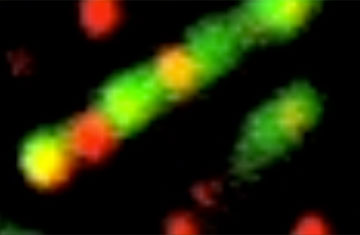
Knock-out bacteria, like the ones shown here that lack parA, are less fit for survival. While wild-type bacterial cells have a consistent number of carboyxsomes, the knockouts either do not have enough or have too many, which leads to slower cell division and less carbon processing.
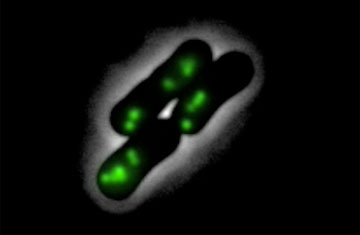
Green-tagged parA proteins gather at one side of the bacterium, shoot to the other end as a cluster, then shoot back. This dynamic seems to be associated with the even spacing of carboxysomes.
Videos courtesy of David F. Savage.
Silver and first authors, research fellows David Savage and Bruno Afonso, attached a fluorescent tag to proteins involved in building the carboxysome, then grew the tagged bacteria under a microscope. The resulting images revealed that instead of being random in number and placement, carboxysomes are built in quantities that scale with the size of the cyanobacteria and are spaced evenly along the length of the bacterial cells (see image 1 below).
The finding suggests new ways of thinking about bacteria. “We had this idea of bacteria as a bag of enzymes, but that has been completely shattered,” said Afonso. The researchers found that a single protein, called parA, acts as a kind of stage manager, arranging the carboxysomes in a neat, single row. When the researchers disabled the bacteria’s ability to make the protein, carboxysomes were distributed far more randomly (see image 2 below).
The cyanobacteria lacking parA were also less fit for survival, said Savage. While wild-type bacterial cells have a consistent number of carboxysomes, optimizing carbon processing and fitness, the knockout bacteria created daughter cells whose number of carboxysomes ranged from none to a superabundance. The daughter cells with few or no carboxysomes divided more slowly and processed 50 percent less carbon than daughter cells at the other end of the spectrum.
By tagging parA in wild-type bacteria, the researchers discovered the protein had notable dynamics. The cyanobacterium creates thousands of parA proteins that repeatedly cluster together and shoot quickly from one end of the bacterium to the other (see video 2 above).
“It’s amazing that you can generate this regularity and symmetry potentially from a single protein,” said Savage. “It’s amazing that it is somehow tuned by the dynamics of the protein.” The researchers have not yet identified the exact mechanism parA uses to govern the spacing.
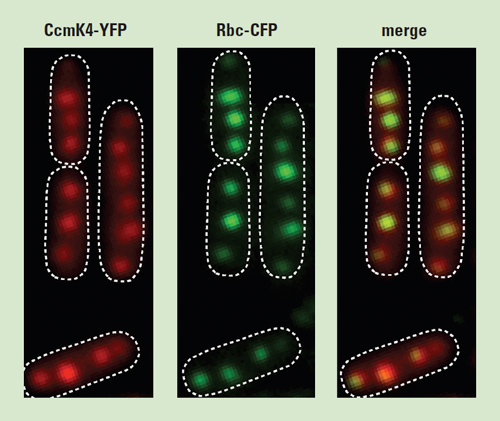
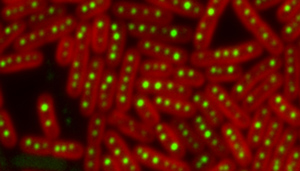
Many other bacteria also have the parA protein, which is known for separating chromosomes during cell division. “This work highlights how bacteria cobble together spare parts to achieve similar goals such as organization and segregation,” said David Rudner, HMS assistant professor of microbiology and molecular genetics, who was not a coauthor on the paper.
These findings may help synthetic biologists one day create designer bacteria. “Knowledge about how cells create and deploy specialized factories like the carboxysome opens the way to creating other kinds of minifactories,” said Richard Losick, Harvard University professor of molecular and cellular biology, who was not a coauthor.
Silver’s lab is looking into whether the carboxysome might be useful for optimizing the production of hydrogen by engineered bacteria. One challenge in designing hydrogen-producing bacteria is that the enzymes that generate hydrogen are sensitive to oxygen. The carboxysome may help solve this problem because its outer shell blocks oxygen, protecting the enzymes inside from its toxic effects.
For more information, students may contact Pamela Silver at pamela_silver@hms.harvard.edu.
Conflict Disclosure: The authors declare no conflicts of interest.
Funding Sources: The U.S. Army Research Office; the authors are solely responsible for the content of this work.
